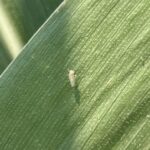 Short story: Spraying to control leafhoppers in dent stage corn is not likely to benefit the crop.
Short story: Spraying to control leafhoppers in dent stage corn is not likely to benefit the crop.
Corn Maturity: As of May 29, 2024, most of the corn in the mid-coast of Texas is at dent. The time required from early dent to maturity is 20-35 days.
Insect populations: Every corn field I have visited has leafhoppers at some level. Leafhopper numbers range from less than 1 per plant to 15-20 per leaf.
Plant symptoms: A minority of the corn fields show symptoms of leaf yellowing to reddening or death and <2% plant death. If the problem is caused by a disease, it is likely a virus or bacterial disease and fungicides will not help the problem. Disease has not been confirmed in these fields.
On May 28, plant and insect samples were sent to the Extension Pathologist in Weslaco for analysis. The analysis will take some time; I expect a couple of weeks.
Corn Stunt: Past records indicate the disease corn stunt is transmitted from plant to plant by corn leafhoppers. Corn stunt has been recorded in Texas as far back as 1945. The disease is a serious disease in South America. The time required from infection to visual symptoms is around 30 days after infection. Published information says not to implement leafhopper control measures after the V9 stage.
Considerations: Insect numbers that would cause plant injury are not documented. There is not a recommended economic threshold. If the leafhoppers feed like aphids, then an economic threshold would be somewhere around 50-100 per leaf. Comparing the infestation timing to mites in corn, the Texas AgriLife Extension corn guide states “Yield losses from mite feeding occur during the grain-filling growth stages, such as tassel to soft dough. Once corn reaches the full dent growth stage, mite feeding does not directly cause yield loss.” I expect the leafhopper injury to be like aphids or mites.
All published information I have found states that insecticidal control will not reduce disease incidence. Insecticides labeled for leafhoppers in corn include: Carbaryl, Pyrethroids, Sivanto, and Malathion. In the Rio Grande Valley, a pyrethroid application by air did not adequately control the leafhoppers. In Victoria, Sivanto was applied to corn at 7 oz/a by ground at 10 gpa on Friday. Monday morning (3 dat) dead leafhoppers were found on the leaves. Control was estimated approximately 80%.
Summary: At this time, I do not recommend treating fields for the control of leafhoppers in corn. The insect is not likely to economically reduce yields greater than the cost of control. If disease develops, the plants are already infected. Infection occurring from leafhoppers today will not show symptoms for 30 days, which is too late to impact grain production.
More information:
Henrique Pozebon, Glauber Renato Stürmer, Jonas André Arnemann. Corn Stunt Pathosystem and Its Leafhopper Vector in Brazil, Journal of Economic Entomology, Volume 115, Issue 6, December 2022, Pages 1817–1833, https://doi.org/10.1093/jee/toac147
Jones TL, Medina RF. Corn Stunt Disease: An Ideal Insect-Microbial-Plant Pathosystem for Comprehensive Studies of Vector-Borne Plant Diseases of Corn. Plants (Basel). 2020 Jun 14;9(6):747. doi: 10.3390/plants9060747. PMID: 32545891; PMCID: PMC7356856. https://www.mdpi.com/742578
Michael Cordonnier. Best Practices Recommended for the Control of Corn Leafhoppers. April 26, 2024. Soybean & Corn Advisor. https://www.soybeansandcorn.com/articles/9957/

